Vancouver, BC / TheNewswire / July 21, 2023 / Global Energy Metals Corporation TSXV:GEMC | OTCQB:GBLEF | FSE:5GE1 (“Global Energy Metals”, the “Company” and/or “GEMC”), a multi-jurisdictional, multi-commodity critical mineral exploration and development company focused on growth-oriented battery metal projects supporting the global transition to clean energy, is pleased to report that its strategic partner, Kingsrose Mining Limited (“Kingsrose”), has completed the acquisition and interpretation of ground based electromagnetic (EM) and magnetotelluric (SPARTAN MT) geophysical surveys at the Bruvann Mine area within the Råna Project, Norway (Figures 1 and 2). In addition, a ground-based MT survey at the Rånbogen prospect and MobileMT survey over the entire Råna intrusive complex are now complete and results will be interpreted over the coming weeks.
Highlights
- Strong apparent conductive bodies with the potential for massive sulphide mineralization have been identified from SPARTAN MT and EM data in three localities proximal to the past-producing Bruvann Mine (Figures 2 to 5):
- West-southwest and down plunge of mined-out massive sulphide mineralisation at Bruvann Mine (Target “Bruvann 01”) (Figure 3).
- West and down plunge of disseminated mineralisation which remains open at Bruvann Mine, as indicated by historical drill results including 20.4 metres at 0.45 % Ni (BG-64-01), 18.3 metres at 0.48 % Ni (bh-1144-02), 23.0 metres at 0.42 % Ni (bh-1143-02) and 11.4 metres at 0.67 % Ni (BG-39-01) (Target “Bruvann 02”) (Figure 4).
- Northeast of the Bruvann Mine located at the contact between country rock and gabbronorite intrusive, locally underlying a lenticular peridotite dyke mapped at surface (Target “Bruvann 03”) (Figure 5).
- Drill testing of the targets is underway to investigate the potential for massive sulphide nickel-copper-cobalt mineralisation associated with the conductive bodies.
- An extension of the EM geophysical survey and downhole EM is expected to be conducted in late July 2023 to further define the targets and provide additional confidence in future drill targeting.
Andrew Tunningley, Kingsrose Head of Exploration, commented:
“The initial geophysical results at Bruvann are highly encouraging in demonstrating the presence of previously unidentified, strongly conductive bodies proximal to the mined-out mineralisation. Our aim is to validate the geophysical interpretation with drilling and follow up detailed geophysics and work towards discovery of new zones of massive sulphide nickel-copper-cobalt mineralisation.”
Fabian Baker, Kingsrose Managing Director, adds:
“Following the MT and EM results reported today, we are eagerly awaiting the final results and interpretations from MT data at the Rånbogen prospect, as well as the MobileMT data which covers the entire Råna intrusion. Our systematic approach to exploration is designed to methodically explore the large and prospective landholding which Kingsrose has consolidated at Råna.”
Discussion of Results
Kingsrose has completed ground based MT and EM surveys at the Bruvann Mine area, with the aim of modelling the local geology and generating exploration targets associated with zones of elevated conductivity which may represent massive sulphide mineralisation. Following is a discussion of the techniques employed, and an interpretation of the results and targets generated.
Magnetotelluric Data
MT is an electromagnetic technique that maps resistivity, to infer sub-surface geology and identify zones of low resistivity (high conductivity) which may correspond with massive sulphide mineralisation. MT is a passive technique which uses natural sources of electromagnetic fields such as lightning and solar flares and is a highly portable technology, capable of detecting a large range of frequencies, resulting in high quality data acquisition to great depths. The MT survey at Bruvann was conducted using a relatively tight station spacing of 200 metres, with the aim of mapping to at least 1000 metres below surface. A three-dimensional model of resistivity was produced to aid interpretation of geology, structure and zones of potential massive sulphide mineralisation. Three zones of high conductivity have been observed in the Bruvann MT data (Figure 2):
- Immediately south of the Bruvann Mine (Figure 2).
- West and down plunge from the Bruvann Mine, 650 metres below surface (targets “Bruvann 01” and “Bruvann 02”) (Figures 3 and 4).
- One kilometre northeast of the Bruvann Mine at the contact between gneiss wall rock and peridotite intrusive rock, from surface and extending to over 1000 metres depth (“Bruvann 03”) (Figure 5).
Mined-out massive sulphide mineralisation occurred at the gradient between very high and moderate conductivities (Figures 2 and 3). The observation that massive sulphide mineralisation occurs at the gradient between very high and moderate conductivities provides Kingsrose with an important vector for targeting other zones of massive sulphide mineralisation. Peridotite, which is the main host rock to high tenor nickel mineralisation, has been modelled from logging of historical drill holes and corresponds with the same MT gradient at the Bruvann Mine. The remainder of the Bruvann Mine occurs as disseminated sulphide mineralisation which is not detectable by MT techniques and does not appear as an anomaly in the MT data, however the disseminated mineralisation is hosted predominantly within peridotite.
Linear, steeply dipping zones of very high conductivity occur in two areas: south of the Bruvann Mine trending east to west, and north of the Bruvann Mine trending northeast (Figure 2). These linear zones are inferred to represent graphitic horizons within the gneiss wall rock and are lower priority targets. Graphitic zones do occur proximal to massive sulphide mineralisation at Bruvann, and clasts of graphite are commonly observed within the massive sulphide, therefore the presence of graphitic horizons proximal to the intrusive contact are considered a locally important control on mineralisation.
Electromagnetic Data
EM surveys are used to identify zones of high conductivity which may represent massive sulphide mineralisation. EM is an active technique where power generators are used to create electromagnetic fields in the sub-surface. Modelling of the data creates conductive ‘plates’, or tabular zones, which are modelled to fit the EM data and aid geological interpretation for detailed drill targeting. Three broad zones of high conductivity were modelled from the EM data:
- Immediately south of the Bruvann Mine, where the modelled plates strike east-west over 800 metres and dip steeply south, coincident with mapped graphite (modelled to a consistent value of around 2000 siemens). However, a sub-parallel plate west of the Bruvann Mine and coincident with a narrow zone of nickel sulphide mineralisation drilled historically represents an important exploration target (Bruvann 01) (Figures 2 and 4).
- 350 metres west of and down-plunge from the Bruvann Mine, at the western limit of the EM survey. Three alternative flat lying plates have been modelled at depths between 350 and 1000 metres below surface, and an extension to the EM survey to better define this target (Bruvann 02) (Figures 2 and 4) is planned for late July 2023.
- Northeast trending, steeply northwest dipping plates located one kilometre northeast of the Bruvann Mine, parallel to the contact between gneiss and the gabbronorite intrusion (Figures 2 and 5). Whilst graphite is mapped at surface in this area, a zone of complex EM plates in the northeast is proximal to a mapped peridotite dyke within the gabbronorite and is undrilled (Bruvann 03).
Target generation from EM and MT data interpretation
Geological mapping, interpretation of historical drill data and processing of MT and EM geophysical data has resulted in the definition of three main target areas at Bruvann (Figure 2):
- Bruvann 01: A strong, 400 by 600 metre MT conductive body is located west and down plunge of the mined-out massive sulphide mineralisation, which is blind at surface and has not been drill tested (Figures 2 and 3). An EM plate has been modelled coincident with the gradient of the MT conductor and is proximal to narrow massive sulphide historical drill intercepts of 1.1 metres at 0.9 % Ni from 278.4 metres and 0.1 metres at 2.7 % Ni from 299.5 metres (P-8-96), which are open in all directions (Figure 4).
- Bruvann 02: The northern gradient of the above MT conductor is coincident with poorly constrained EM plates at the western extremity of the survey area (Figures 2 and 4). This target is 350 metres west and down dip of the Bruvann Mine where mineralisation is open, including historical drill intercepts from underground drill stations, for example 20.4 metres at 0.45 % Ni (BG-64-01), 18.3 metres at 0.48 % Ni (bh-1144-02), 23.0 metres at 0.42 % Ni (bh-1143-02) and 11.4 metres at 0.67 % Ni (BG-39-01)
- Bruvann 03: An MT conductor coincident with a modelled EM plate occurs at the contact between gneiss and a peridotite dyke hosted in gabbronorite, located one kilometre northeast of the Bruvann Mine (Figures 2 and 5). The conductor continues from surface to over one kilometre below surface and drilling will test both the EM plate and the gradient between very high and moderate conductivities. This is inferred to represent a zone of potential massive sulphide mineralisation at the contact between peridotite and gneiss wall rock with graphite horizons.
Follow up work to test the above targets will include diamond drilling as part of the current program and an extension to the ground EM survey, due to commence at the end of July 2023. The purpose of this is to better define the location and orientation of the Bruvann 02 target prior to drill testing. Downhole EM surveys will be completed at the same time as the extension to the ground EM, to generate and refine additional drill targets.
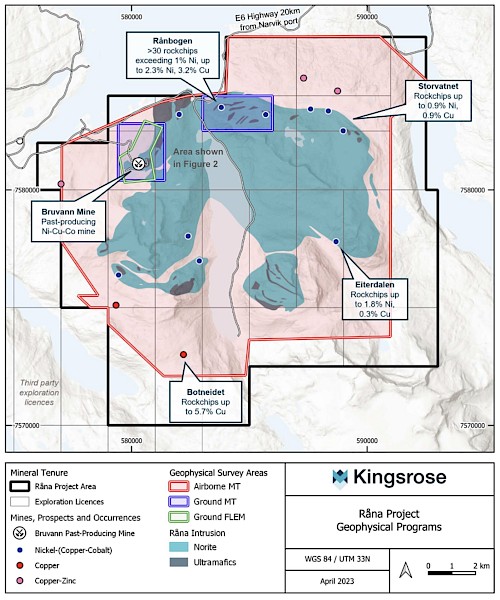
Figure 1: Råna Project area and location of 2023 geophysical programs
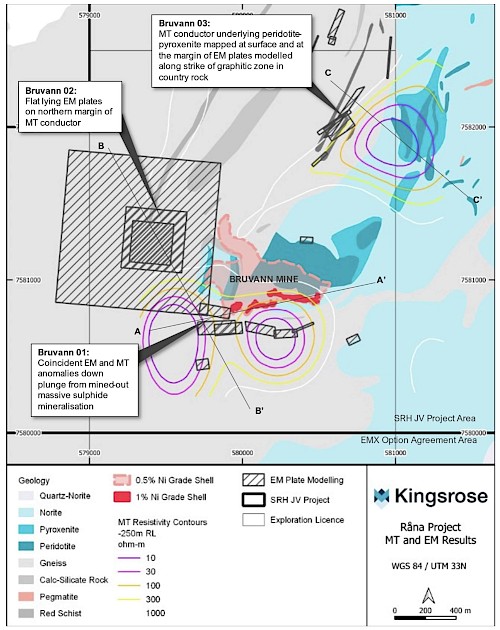
Figure 2. Map showing priority exploration targets at the Bruvann Mine Area, Råna Project
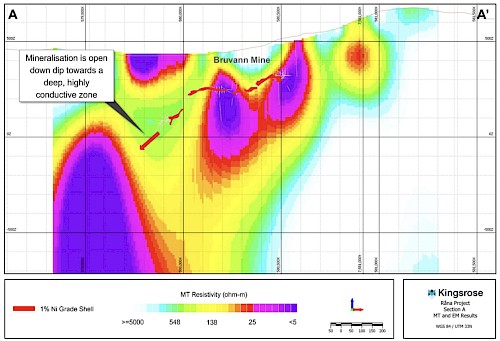
Figure 3: Long section (Section A-A’) showing MT data and exploration targets at Bruvann Mine. Note that mined out high grade mineralisation occurs on a strong MT gradient between high and moderate conductive zones.
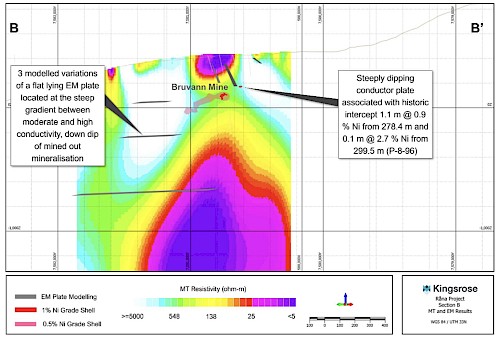
Figure 4: Cross section (Section B-B’) showing modelled EM plates and deep MT conductive target to the west of Bruvann Mine.
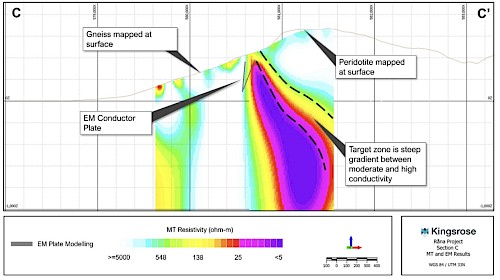
Figure 5: Cross section (Section C-C’) showing MT data and modelled MT plates. The large MT conductive body is located at the contact between host gneiss and the Råna intrusion, and underlies a peridotite dyke mapped at surface.
Kingsrose Mining Limited
Kingsrose is a leading sustainability-conscious and technically proficient mineral exploration company listed on the ASX. The Company has a discovery-focused strategy, targeting the acquisition and exploration of critical mineral deposits having Tier-1 potential, that has resulted in the acquisition of, or joint venture into, the Råna nickel-copper-cobalt, Penikat PGE and Porsanger PGE-nickel-copper projects in Finland and Norway. Additionally, Kingsrose has been selected for the first cohort of the BHP Xplor exploration accelerator program which commenced in January 2023.
Qualified Person
Mr. Paul Sarjeant, P. Geo., a Director and shareholder is the qualified person for this release as defined by National Instrument 43-101 - Standards of Disclosure for Mineral Projects.
For Further Information:
Global Energy Metals Corporation
#1501-128 West Pender Street
Vancouver, BC, V6B 1R8
Email: info@globalenergymetals.com
t. + 1 (604) 688-4219
Twitter: @EnergyMetals | @USBatteryMetals | @ElementMinerals
Global Energy Metals Corporation
(TSXV:GEMC | OTCQB:GBLEF | FSE:5GE1)
Global Energy Metals Corp. offers investment exposure to the growing rechargeable battery and electric vehicle market by building a diversified global portfolio of exploration and growth-stage battery mineral assets.
Global Energy Metals recognizes that the proliferation and growth of the electrified economy in the coming decades is underpinned by the availability of battery metals, including cobalt, nickel, copper, lithium and other raw materials. To be part of the solution and respond to this electrification movement, Global Energy Metals has taken a ‘consolidate, partner and invest’ approach and in doing so have assembled and are advancing a portfolio of strategically significant investments in battery metal resources.
As demonstrated with the Company’s current copper, nickel and cobalt projects in Canada, Australia, Norway and the United States, GEMC is investing-in, exploring and developing prospective, scaleable assets in established mining and processing jurisdictions in close proximity to end-use markets. Global Energy Metals is targeting projects with low logistics and processing risks, so that they can be fast tracked to enter the supply chain in this cycle. The Company is also collaborating with industry peers to strengthen its exposure to these critical commodities and the associated technologies required for a cleaner future.
Securing exposure to these critical minerals powering the eMobility revolution is a generational investment opportunity. Global Energy Metals believes Now is the Time to be part of this electrification movement.
Cautionary Statement on Forward-Looking Information:
Certain information in this release may constitute forward-looking statements under applicable securities laws and necessarily involve risks associated with regulatory approvals and timelines. Although Global Energy Metals believes the expectations expressed in such forward-looking statements are based on reasonable assumptions, such statements are not guarantees of future performance and actual results or developments may differ materially from those in the forward-looking statements. Except as required by law, the Company undertakes no obligation to update these forward-looking statements in the event that management’s beliefs, estimates or opinions, or other factors, should change.
GEMC’s operations could be significantly adversely affected by the effects of a widespread global outbreak of a contagious disease, including the recent outbreak of illness caused by COVID-19. It is not possible to accurately predict the impact COVID-19 will have on operations and the ability of others to meet their obligations, including uncertainties relating to the ultimate geographic spread of the virus, the severity of the disease, the duration of the outbreak, and the length of travel and quarantine restrictions imposed by governments of affected countries. In addition, a significant outbreak of contagious diseases in the human population could result in a widespread health crisis that could adversely affect the economies and financial markets of many countries, resulting in an economic downturn that could further affect operations and the ability to finance its operations.
For more information on Global Energy and the risks and challenges of their businesses, investors should review the filings that are available at www.sedar.com.
Neither TSX Venture Exchange nor its Regulation Services Provider (as that term is defined in the policies of the TSX Venture Exchange) accepts responsibility for the adequacy or accuracy of this release.
We seek safe harbour.
